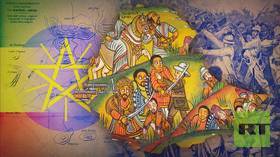Empire of salt and gold: Where did the richest man in the world come from?
In the Middle Ages a single civilization boasting unparalleled riches linked the Sahara to the Arab world and Europe
The pre-colonial history of African countries deserves close attention. The African continent became a place where great trading empires were born and flourished during the Middle Ages. The Sahel zone, the African ‘sandy coast’, which is a belt of land stretching from the Atlantic Ocean to the Red Sea, became a kind of civilizational center for the continent. It was here that some of the first African countries arose.
The Mali Empire, which covered the territories of modern Mali, Guinea, Senegal, Niger, and Mauritania, existed from the 13th to the 16th centuries. Originating in the vicinity of West Africa’s main trade and logistics artery, the Niger River, the empire became known throughout the world and reached its peak of prosperity thanks to one of its rulers, Mansa Musa.
According to various studies, Mansa Musa was in power for more than two decades – from 1307/1312 to 1332/1337 – and became the ninth ruler, or mansa, of the empire. Translated from the Maninka language, mansa means ‘king’ or ‘ruler’. Despite his relatively short reign, his rule led to the rapid economic development of the Mali Empire, the expansion of its territory, and a rise in science and culture.
The ruler gained worldwide fame due to his untold wealth – even in the 21st century, Mansa Musa is recognized as the richest man in the history of mankind. In 2014, the publication Celebrity Net Worth estimated that, by modern standards, the ruler’s fortune would amount to $400 billion, which exceeds the capital of the Rothschild family and such figures as American entrepreneur John D. Rockefeller.
Sources of wealth
It is rather difficult to make an accurate assessment of Mansa Musa’s total personal wealth, since in the Middle Ages the concepts of a ruler’s personal wealth and the general state of the empire are generally closely intertwined.
In the 14th century, just as in the 21st, untold wealth was accumulated due to the country’s strategic location. Covering most of the Niger River valley and the surrounding areas of the Sahara Desert, the Mali Empire controlled the main routes along which the lucrative gold and salt trade with both Arab and Mediterranean countries took place. At that time, gold had already become both a symbol of prestige and a settlement currency, while salt was necessary for preserving food. This made these commodities essential for meeting the key needs of that time.
Deposits of basic commodities were also located on the empire’s territory, and Mali’s geographical location allowed its ruler to set taxes and trade duties, as well as to regulate the logistics chains of that time. The former brought the largest revenues to the state coffers.
Thus, the Mali Empire occupied a central position in trans-Saharan trade, connecting West Africa, the Mediterranean, and the Arab world.
Pilgrimage to Mecca and world fame
In 1324, after more than a decade in power, Mansa Musa fulfilled the duty of every wealthy Muslim – he carried out the Hajj, or pilgrimage to Mecca. It was through this journey that the world learned about the wealth of both the Mali Empire and the ruler himself.
Mansa Musa went to Mecca accompanied by a large retinue. The size of the entire procession was 60,000 people, while Mansa’s personal escort numbered 12,000 slaves. The most striking part of the procession was 500 slaves, each of whom held an ingot of gold or a staff decorated with gold. In addition, the delegation was accompanied by 80 camels, which were also loaded down with gold. Michael A. Gomez, a professor at New York University and a specialist in the history of West Africa, suggests that the volume of gold taken on the Hajj could have been up to 18 tons.
Such a procession could not go unnoticed. An equally important purpose of the pilgrimage was to demonstrate one’s wealth and power. On the way to Mecca, the delegation passed through the territory of modern Mauritania, Algeria, and Egypt. Throughout the journey, Mansa Musa generously shared his wealth and distributed gold to all the poor and needy he met on the road. Upon his arrival in Cairo, which was capital of the Mamluk Sultanate at that time, the emperor’s huge outlays of gold even drove down its price, disrupting the stability of local markets.
Mansa Musa’s pilgrimage led to unprecedented growth in the power of the empire and increased trade turnover. Gold began to course through the markets of Mediterranean countries, undermining their economies, which only contributed to developing the trans-Saharan trade routes, while elevating the role of the Mali Empire as its main trading center.
Culture and science flourishing
Thanks to its success in the economic sphere and the growing number of foreign traders arriving in Mali, the empire’s territory expanded and developed. New cities emerged, built in accordance with the latest architectural trends. There was active construction of religious buildings – mosques and madrasas, where scientific centers were established.
After the end of Mansa Musa’s Hajj, the port cities of Timbuktu and Gao became part of the Mali Empire. For their construction, the emperor attracted Muslim architects from the Middle East and continental Europe. Among them was Abu Ishaq al-Saheli, a native of the Al-Andalus region, a Muslim territory on the Iberian peninsula now known as the Spanish region of Andalusia.
Under the leadership of al-Saheli, five mosques were built, among them the Djinguereber Mosque, built in Timbuktu in 1327, which has been partially preserved to this day.
Other notable historical and cultural monuments include the Sankore Mosque, which was built in the same period, and the Sidi Yahia Mosque, which was completed after the end of Mansa Musa’s reign. Along with the Jingereber Mosque, these formed a local scientific cluster – the University of Sankore.
Quranic education began to develop in the region in the 11th century. However, during the heyday of the Mali Empire, Muslim scholars began to flock to the region from all over the world, which contributed to the development of a local scientific school. By the end of Mansa Musa’s reign, the University of Sankore had the largest library on the continent, with an extensive collection of books and manuscripts.
The city of Timbuktu became the main Islamic scientific center in West Africa. First and foremost, scientists worked on manuscripts, especially in Arabic, using the Ajami script, which is based on Arabic graphics and adapted to African languages. The collection of manuscripts includes works on astronomy, mathematics, medicine, and philosophy, as well as religious works and numerous transcriptions of the Quran.
Manuscripts from Timbuktu are still being translated and studied to this day. Over the past decades, a number of international projects have been launched, aimed at preserving and deciphering manuscripts. Three of them have become the most ambitious. These are the Norwegian Timbuktu Manuscripts Project (University of Oslo), Timbuktu Manuscripts (governments of Luxembourg and Mali), and the Timbuktu Manuscripts Project by the University of Cape Town, implemented with the support of the African Union’s New Partnership for Africa’s Development (NEPAD) and the government of South Africa. The entire collection of manuscripts numbers from 400,000 to 500,000 copies.
Legacy and fall of the empire
The reign of Mansa Musa is often called the Golden Age of the Mali Empire. According to estimates by the Oxford Centre for Global History, he ruled over the territories of modern Senegal, Mali, Guinea and Guinea-Bissau, as well as Mauritania, Burkina Faso, Gambia, and Ivory Coast.
Not only the empire’s territorial expansion, but also its cultural flourishing – the rapid development of construction, international relations, and science, which subsequently continued – testify to the high level of Mansa Musa’s managerial and diplomatic abilities.
However, despite the continued growth in the cultural sphere, with the death of Mansa Musa, the political development of the state began to experience a crisis. Under Mansa Musa’s heirs, the power of the empire was significantly reduced, which was facilitated by both internal socio-economic discrepancies and external pressure, which the new leaders were unable to cope with well enough to hold the empire’s vast territory the together.
The territories sought to separate from the center in order to pursue their own economic policies and increase prosperity, and the disorder of the succession led to internal strife and the weakening of the state. The lands in the east of the country and then the cities of Timbuktu and Gao, the main economic and cultural centers, were absorbed by the Songhai people, who were strengthening their power at that time.
By the middle of the 15th century, the Mali Empire had lost most of its territory to the north, suffered frequent attacks on trade routes, and faced pressure from the east from the growing Songhai Empire, which later completely absorbed Mali.
The fall of the Mali Empire as Europe’s main gold supplier led to changes around the world, and to some extent prodded European countries into expanding into both Latin America and Africa’s coastal areas in search of new sources of precious metals.
Portugal, the largest maritime power of the time, was highly dependent on gold coming from Mali through Morocco. It was these funds that were used to explore the lands of the New World. The destruction of the usual trading network and the establishment of colonies in West Africa’s coastal zone after the fall of the Mali Empire allowed the Portuguese to mine gold in the region without the need for intermediaries.
Despite the demise that all great empires come to sooner or later, the period of Mali’s heyday under the leadership of Mansa Musa is enshrined in the material wealth of that era, as well as the collective memory of the Mande peoples that formed the basis of the country’s population.








Comments are closed.